Hello, fellow cat lovers! Are you curious about your furry friend’s behavior and personality? Look no further! I’m here to introduce you to our ‘Is My Cat Feral Quiz’ – a helpful tool designed to provide insights into your cat’s behavior and whether they display feral or domestic traits. By understanding your cat better, you can enhance your bond and provide the best care possible.
So, what are you waiting for? Let’s dive into the quiz and unravel the mysteries of your feline companion’s persona!
Key Takeaways:
- Our ‘Is My Cat Feral Quiz’ offers valuable insights into your cat’s behavior and helps determine if they exhibit feral or domestic traits.
- Understanding your cat’s socialization status is crucial for tailoring your interactions and care accordingly.
- Assessing a cat’s socialization status involves observing behavior, performing tests, and considering factors like physical appearance and past experiences.
- The community cat concept includes both feral and stray cats and requires specific care and engagement.
- Building trust with your cat involves routines, positive interactions, understanding body language, and creating a secure environment.
What is a Feral Cat?
A feral cat is a term used to describe a cat that has little to no socialization with humans and lives primarily outdoors. Unlike stray cats, which may have had some level of interaction with people, feral cats are often born into a feral colony or have become feral due to abandonment or being lost for an extended period. These cats are self-reliant and have developed survival instincts to navigate their outdoor environment.
Feral cats typically avoid human contact and may display defensive behaviors when approached. They are not accustomed to living in a domestic setting and do not rely on humans for food, shelter, or companionship. Due to their unsocialized nature, attempts to handle or interact with feral cats can be difficult and may result in stress or aggression.
| Feral Cat | Stray Cat | Outdoor Cat |
|---|---|---|
| Limited or no socialization with humans | May have had some interaction with humans | May have an owner or regular contact with humans |
| Lives primarily outdoors | May live outdoors or seek shelter in various locations | May have the option to go indoors or outdoors |
| Relies on their instincts for survival | Might rely on humans or other food sources | May rely on humans for food, shelter, and care |
Understanding the difference between feral cats and other types of Outdoor Cats is important for cat owners as it determines the approach to interact and care for them. While feral cats can be challenging to socialize, stray cats may be more receptive to human contact and could potentially be socialized and adopted. On the other hand, outdoor cats that have owners may require regular veterinary care and provision of a safe and comfortable environment both indoors and outdoors.
Socialization Spectrum of Cats
In order to truly understand our feline companions, it is important to recognize that cats fall on a socialization spectrum. This spectrum ranges from completely feral, with minimal to no socialization, to fully socialized cats that have had regular contact with humans. The socialization status of a cat plays a significant role in their behavior and relationship with humans.
By understanding where a cat falls on the socialization spectrum, cat owners can tailor their interactions and care to meet their cat’s specific needs. It is important to remember that every cat is unique and may exhibit varying degrees of socialization.
Below is a visual representation of the socialization spectrum of cats:
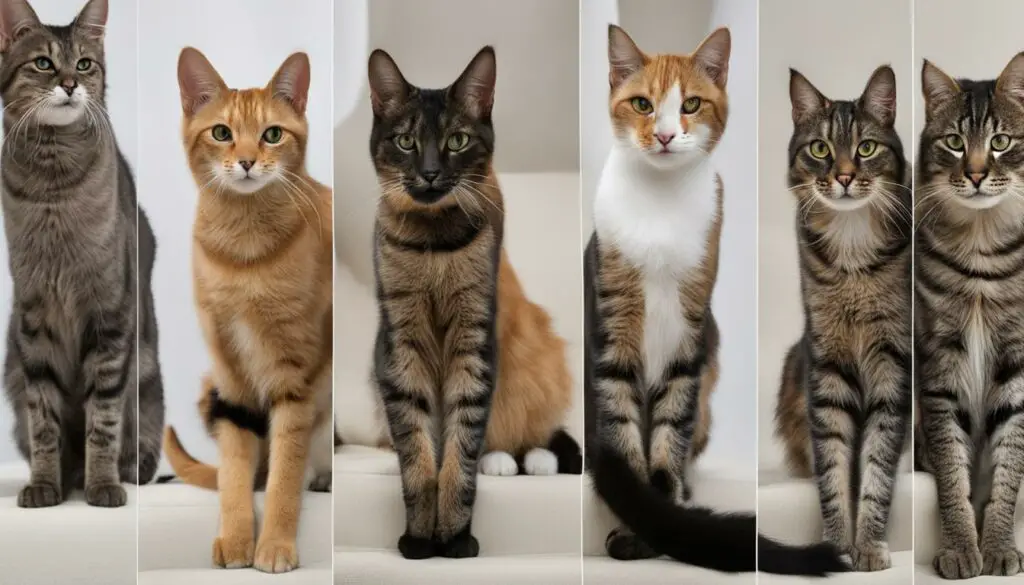
| Socialization Level | Description |
|---|---|
| Feral | Cats that have had minimal to no socialization with humans. They are typically unsocialized and may display fearful or aggressive behavior. |
| Semi-Feral | Cats that have had some level of socialization with humans but may still exhibit skittish or cautious behavior. |
| Semi-Socialized | Cats that have had moderate socialization with humans and are comfortable being around them but may still be wary of unfamiliar people or situations. |
| Friendly | Cats that have had extensive socialization with humans and are comfortable being handled and interacting with people. |
Understanding the socialization spectrum of cats allows cat owners to better navigate their cat’s behavior and provide the appropriate care and environment for their feline companions. By recognizing and respecting a cat’s socialization level, we can ensure their well-being and foster a positive and loving relationship.
Assessing a Cat’s Socialization Status
Assessing a cat’s socialization status is crucial for shelters and cat welfare organizations in determining whether a cat is feral or has the potential to be socialized and adopted. Various methods are used to evaluate a cat’s behavior, including observation, tests, and consideration of other factors such as physical appearance and past experiences.
Observation plays a significant role in assessing a cat’s socialization status. Shelters and organizations closely observe a cat’s interactions with humans and other animals, looking for signs of fear or aggression, as well as any indications of trust or willingness to engage. Additionally, behavioral tests may be conducted to assess a cat’s response to different stimuli, such as toys or handling, providing further insights into their socialization level.
It’s important to consider additional factors when assessing a cat’s socialization status. Physical appearance, such as grooming habits and overall health, can provide clues about a cat’s past experiences and level of socialization. Information about the cat’s background, such as whether they were found as a stray or surrendered by their previous owner, can also provide valuable context.
| Assessment Methods | Description |
|---|---|
| Behavioral Observation | Close observation of a cat’s interactions with humans and other animals to evaluate their socialization level. |
| Behavioral Tests | Conducting specific tests to assess a cat’s response to different stimuli, providing additional insights into their socialization status. |
| Physical Appearance | Evaluating grooming habits and overall health as indicators of a cat’s socialization level and past experiences. |
| Background Information | Considering the cat’s history, such as whether they were found as a stray or surrendered by their previous owner, to gain a better understanding of their socialization status. |
Assessing a cat’s socialization status requires a comprehensive approach that takes into account various factors, including behavioral observation, tests, physical appearance, and background information. By utilizing these assessment methods, shelters and organizations can make informed decisions about the best course of action for each cat, whether it involves socializing them for adoption or providing alternative options for feral cats.
Holding Periods & Outcome Options for Feral Cats
When it comes to feral cats, shelters follow minimum holding periods to determine their socialization status and identify the best outcome options. The holding period allows shelters to assess the behavior of feral cats over a certain period of time, helping them understand if the cats can be socialized or if they are better suited for other alternatives.
During the holding period, shelters provide the necessary care, including food, water, and medical attention, to ensure the well-being of feral cats. The length of the holding period may vary between shelters, but it is typically a few days to a few weeks. This period allows the cats to acclimate to their surroundings and gives the shelter staff time to observe their behavior.
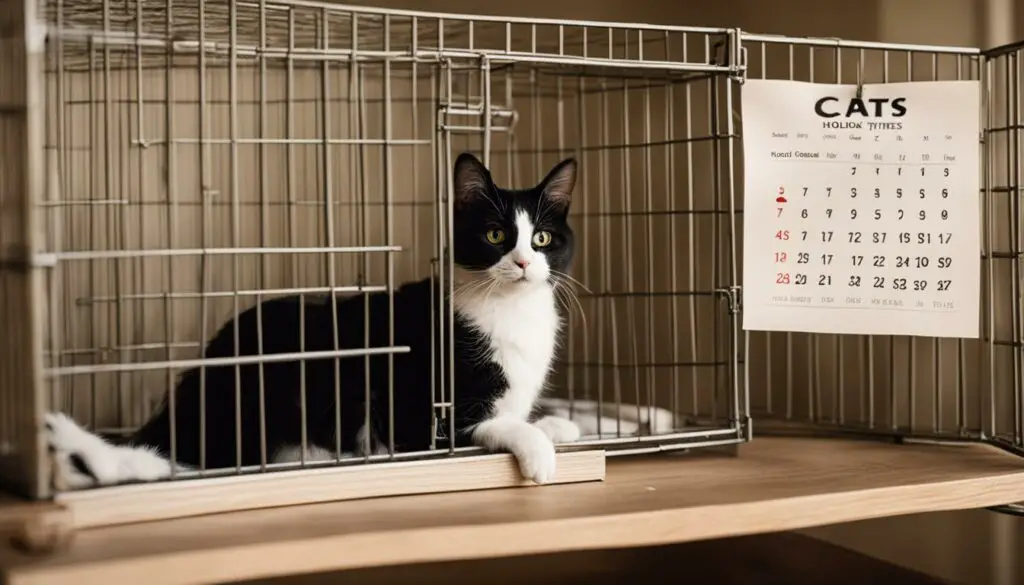
| Outcome Options | Description |
|---|---|
| Trap-Neuter-Return (TNR) Programs | TNR programs involve trapping feral cats, spaying or neutering them, and then returning them to their original location. This approach helps control the feral cat population and ensures their welfare. |
| Adoption | In some cases, feral cats may show potential for socialization. Shelters may work with experienced foster families or adopters who are willing to provide the time and patience required to help the cats adjust to a domestic environment. |
| Euthanasia | Unfortunately, some feral cats may be deemed unadoptable due to severe aggression or health issues. In such cases, shelters may have to make the difficult decision to euthanize the cats to prevent suffering. |
It is important to note that the outcome options for feral cats can vary based on the policies and resources of each shelter. The goal is always to ensure the best possible outcome for the individual cats while considering their welfare and the safety of the community.
The Community Cat Concept
In this section, I will introduce the concept of community cats, which includes both feral and stray cats. Community cats are unowned cats that live outdoors and often form colonies. These cats rely on their natural instincts to survive and typically have minimal or no contact with humans. Understanding the community cat concept is crucial for cat owners and caregivers in engaging with and providing appropriate care for these cats.
“Community cats, also known as feral cats, are part of our urban landscape. They are not socialized to humans and prefer to live outdoors. Managing their population through humane methods like Trap-Neuter-Return helps stabilize their numbers while ensuring their well-being.”
When it comes to community cats, it’s essential to recognize that they are different from domesticated cats. While domesticated cats are accustomed to living with humans and rely on them for care and companionship, community cats have adapted to life outdoors. They often form colonies and establish complex social structures within their groups. By understanding the unique characteristics and needs of community cats, we can work towards coexisting with them and ensuring their welfare.
To provide a comprehensive overview of the community cat concept, let’s take a look at the table below:
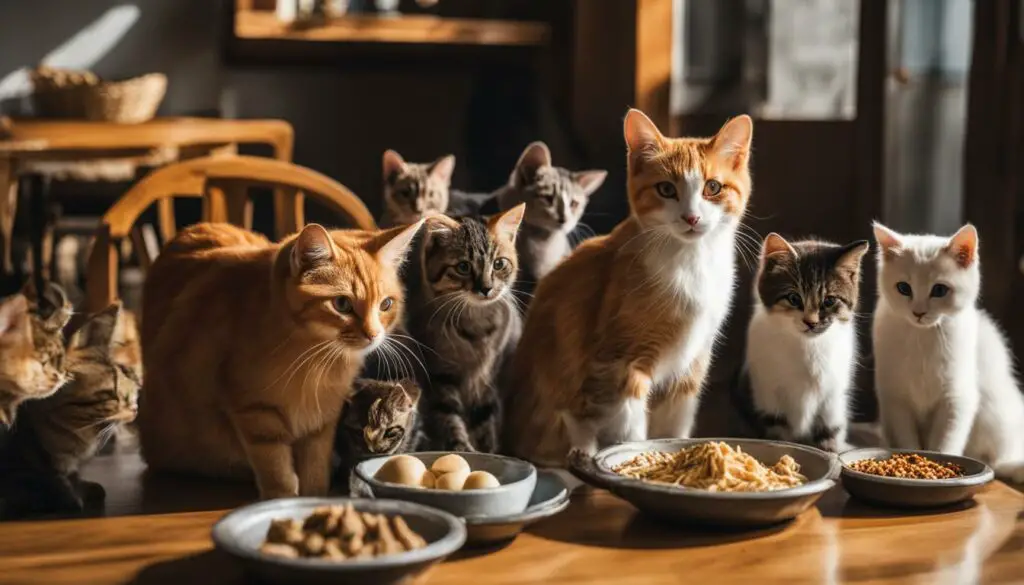
By referring to the table, we can gain valuable insights into the differences between feral, stray, and community cats. This knowledge enables cat owners and caregivers to approach and support these cats in a way that respects their natural instincts and behaviors, ultimately promoting their well-being and establishing a harmonious coexistence.
Difference Between Feral and Stray Cats
Understanding the difference between feral and stray cats is crucial for cat owners and caregivers when encountering outdoor cats. While both feral and stray cats live outdoors, there are distinct characteristics that differentiate them.
A stray cat is a cat that was once a pet but has become lost or abandoned. These cats have had some level of socialization with humans and may approach people for food or shelter. Stray cats are often more open to being approached and can potentially be rehomed or brought indoors with proper care and socialization efforts.
On the other hand, a feral cat is a cat that has had little to no socialization with humans and is typically wary of close contact. Feral cats are usually born in the wild or have been abandoned at a young age, causing them to develop survival instincts that prioritize avoiding human interaction. As a result, feral cats are not easily approachable and may exhibit more wild behaviors.
Table: Differences Between Feral and Stray Cats
| Feral Cats | Stray Cats |
|---|---|
| Minimal to no socialization with humans | Some level of socialization with humans |
| Wary and avoidant of close contact | May approach humans for food or shelter |
| Typically born in the wild or abandoned at a young age | Lost or abandoned pets |
| May exhibit more wild behaviors | May still exhibit some domestic behaviors |
Recognizing whether a cat is feral or stray helps determine the best approach to interact with them and provide appropriate care. Feral cats often benefit from Trap-Neuter-Return (TNR) programs, where they are spayed or neutered, vaccinated, and returned to their outdoor colonies. Stray cats, on the other hand, may be candidates for adoption or rehoming efforts.
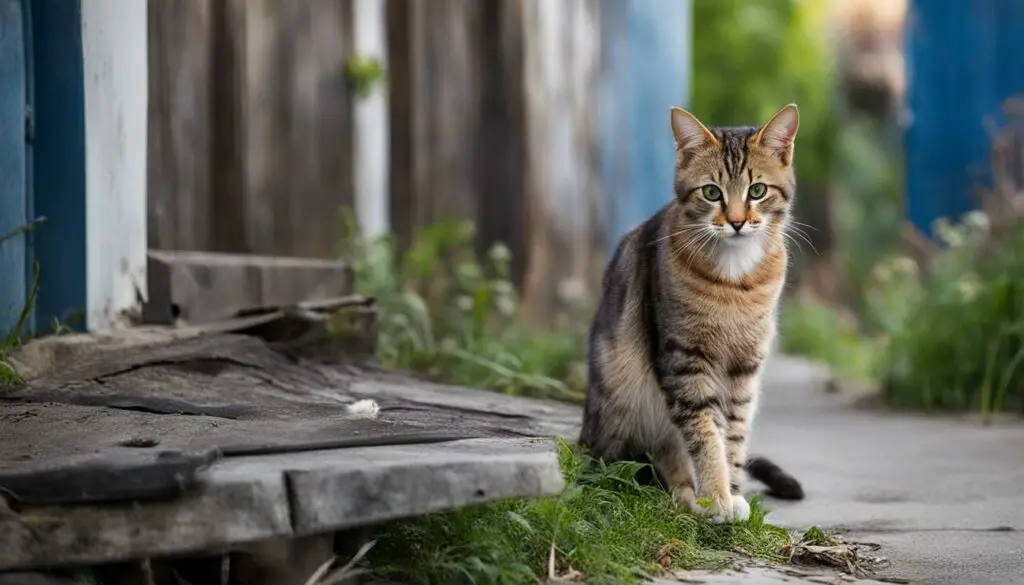
In summary, feral cats and stray cats differ in their level of socialization with humans and their behavior towards people. Understanding these differences allows cat owners to make informed decisions about how to approach and engage with outdoor cats, ultimately ensuring their well-being and the well-being of the feline community as a whole.
Signs of Trust in Cats
Building trust with your cat is essential for establishing a strong and loving bond. Cats are unique creatures, and they have subtle ways of showing their trust in us. By understanding these signs, you can better gauge the depth of your cat’s trust and nurture a harmonious relationship.
Here are some common signs that indicate your cat trusts you:
- Seeking companionship: Your cat chooses to spend time with you, seeking your presence and company.
- Slow blinking: Cats often show trust by giving you a slow blink, closing their eyes halfway and opening them again. It signifies that they feel safe and relaxed in your presence.
- Kneading: When a cat kneads its paws on you, it’s a sign that they trust and feel comfortable with you. This behavior is reminiscent of kittenhood when they kneaded their mother’s belly for milk.
- Headbutting: Cats may gently bump their heads against you as a sign of affection and trust. It’s their way of marking you with their scent and showing that they consider you part of their family.
- Showcasing their belly: Cats expose their vulnerable underside, including their belly, when they feel safe and secure in your presence. It indicates that they trust you enough to let their guard down.
- Grooming you: Cats groom themselves to maintain cleanliness and show affection. If your cat licks your hair or clothes, it’s their way of bonding and expressing trust.
- Vocalizing: Cats may vocalize in various ways, such as purring, chirping, or meowing, to communicate their trust and contentment in your presence. Each cat has its unique vocalizations.
Remember, trust is built over time through consistent care, respect, and positive interactions. It’s essential to be patient and understanding as your cat gradually opens up to you.
Table: Signs of Trust in Cats
| Signs of Trust | Description |
|---|---|
| Seeking companionship | Your cat chooses to spend time with you, seeking your presence and company. |
| Slow blinking | Cats give you a slow blink, closing their eyes halfway and opening them again, to show that they feel safe and relaxed in your presence. |
| Kneading | Cats knead their paws on you as a sign of trust and comfort. It’s a behavior acquired from kittenhood when they kneaded their mother’s belly for milk. |
| Headbutting | Cats gently bump their heads against you to mark you with their scent and show that they consider you part of their family. |
| Showcasing their belly | Cats expose their vulnerable underside, including their belly, when they feel safe and secure in your presence. |
| Grooming you | Your cat may groom your hair or clothes, showing affection and bonding. |
| Vocalizing | Cats vocalize in various ways, such as purring, chirping, or meowing, to express trust and contentment. |
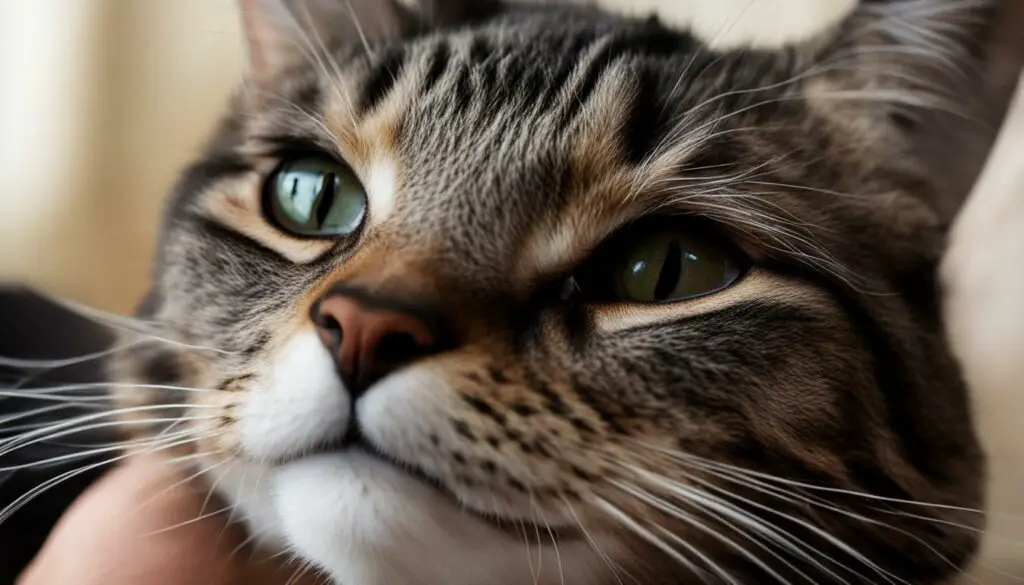
Building Trust with Your Cat
Building trust with your cat is essential for fostering a strong and loving bond. Cats are naturally cautious creatures, and earning their trust requires patience, understanding, and consistency. By following these tips and strategies, you can create a secure and nurturing environment that encourages your cat to trust and feel comfortable around you.
Establish Routines
Cats thrive on routine, so establishing consistent daily schedules can help build trust. Regular feeding times, play sessions, and quiet moments of bonding can create a sense of predictability for your cat. This consistency allows your cat to feel secure and helps strengthen the trust they have in you.
Positive Interactions
Using positive reinforcement is key to building trust with your cat. Rewarding good behavior with treats, gentle petting, and soothing words can help your cat associate you with positive experiences. Avoid any form of punishment or negative interactions, as this can erode trust and cause fear or anxiety in your cat.
Understanding Body Language
Being able to interpret your cat’s body language is crucial for building trust. Pay attention to their tail movements, ear positions, and overall posture to gauge their comfort level. Respect their boundaries and give them space when they show signs of being overwhelmed or anxious. By understanding and responding to their cues, you demonstrate your respect and care for their needs.
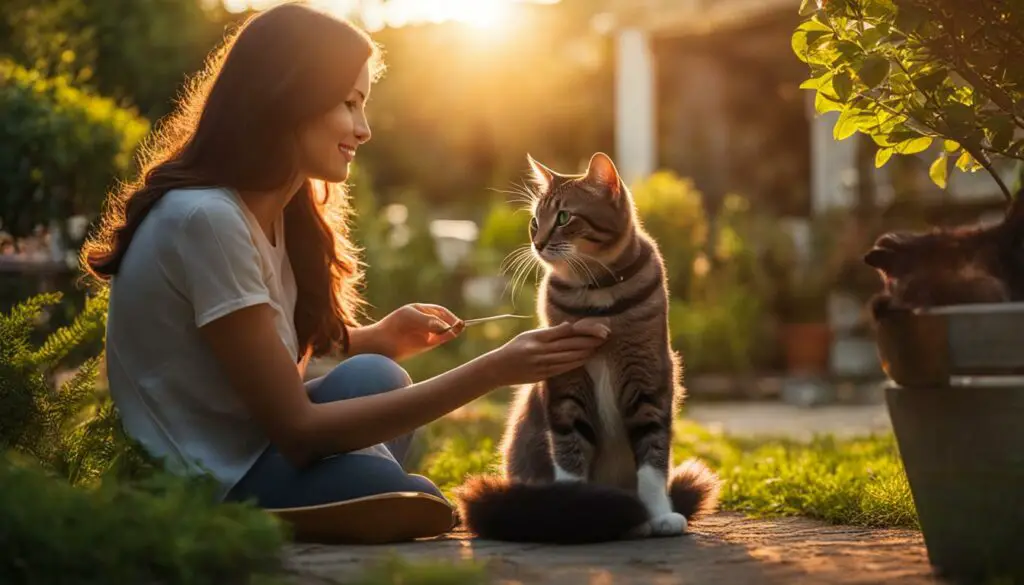
Respecting their Space
Allowing your cat to have their own space is essential for building trust. Provide hiding spots, cozy beds, and vertical climbing areas where they can retreat to when they need some alone time. Respecting their personal space shows them that you understand and respect their boundaries, which is crucial for establishing a trusting relationship.
Assessing Your Cat’s Trust Level
Building trust with your cat is essential for fostering a strong bond and ensuring a harmonious relationship. To assess your cat’s trust level, observe their behavior and look for specific indicators of trust. Here are some key signs that can help you determine the level of trust your cat has in you:
- Spending time together: Cats who trust their owners will actively seek out their company and enjoy spending time together.
- Love blinks: Slow blinking is a sign of trust and relaxation in cats. If your cat gives you love blinks, it’s a positive indication of their trust.
- Kneading: Kneading, also known as “making biscuits,” is a behavior cats exhibit when they feel comfortable and safe.
- Headbutting: Cats often engage in headbutting to mark their territory and show affection. If your cat headbutts you, it’s a sign of trust.
- Sleeping near you: Cats are vulnerable when they sleep, so if your cat chooses to sleep in close proximity to you, it shows a high level of trust.
Remember that every cat is unique, and trust may develop at different rates. Some cats may show these indicators sooner, while others may take more time to fully trust their owners. It’s important to be patient, consistent, and respectful of your cat’s boundaries as you build trust together.
By understanding and assessing your cat’s trust level, you can tailor your interactions to strengthen the bond between you and your feline companion. Building trust is a gradual process that requires time, consistency, and positive experiences. As your cat’s trust grows, you’ll enjoy a deeper connection and a more fulfilling relationship with your furry friend.
The Importance of Trust in the Cat-Human Relationship
The bond between a cat and its owner is built on trust. Trust is the foundation that allows for a harmonious and loving relationship between humans and their feline companions. When cats trust their owners, they feel safe, secure, and can fully express their natural behaviors and personalities. As cat owners, it is our responsibility to nurture and strengthen this trust, as it is key to promoting the overall well-being and happiness of our beloved cats.
Trust is not something that can be forced upon a cat; it must be earned through patience, understanding, and positive experiences. Taking the time to build trust with your cat is essential, especially if you have adopted a feral or unsocialized cat. These cats may have had limited or negative experiences with humans, making it crucial to approach them with sensitivity and respect. By demonstrating consistent love, kindness, and providing a secure environment, you can gradually earn their trust and help them feel more comfortable in your presence.
Building trust with your cat involves paying attention to their body language and respecting their boundaries. It’s important to allow them to initiate interactions and provide them with choices. Positive reinforcement, such as treats and rewards, can also be effective in building trust. Additionally, engaging in activities that your cat enjoys, such as playtime or grooming, can help strengthen the bond between you. Remember, building trust takes time and patience, but the rewards are immeasurable – a deep connection and a mutually fulfilling relationship with your cat.
| Benefits of Trust in the Cat-Human Relationship | Ways to Build Trust with Your Cat |
|---|---|
|
|
Fostering Trust with Cats: Conclusion
In conclusion, building trust with your cat is a crucial aspect of nurturing a strong and fulfilling relationship. By understanding the socialization spectrum of cats and assessing your cat’s trust level, you can tailor your interactions and create a secure and loving environment for your feline companion. Trust can be built through consistent routines, positive reinforcement, and respecting your cat’s boundaries. The ‘Is My Cat Feral Quiz’ serves as a valuable tool in understanding your cat’s behavior and socialization status, providing insights into their unique needs and preferences.
Remember that trust is a two-way street, and it requires time and patience. By observing the signs of trust in cats, such as seeking companionship, slow blinking, and grooming, you can gauge the strength of your bond with your cat. Building trust not only enhances the cat-human relationship but also promotes a sense of security and well-being for your furry friend.
To summarize, fostering trust with cats involves gaining a deep understanding of their behavior, meeting their needs, and creating a safe and loving environment. Through positive interactions, consistent care, and respect for their individuality, you can forge a bond built on trust. So take the time to engage with your cat, communicate effectively, and enjoy the rewarding journey of building trust and strengthening your relationship.

Additional Resources:
- Cat Trust 101 – A comprehensive guide to understanding and building trust with your feline companion.
- Building Trust: Tips and Techniques – Practical strategies and techniques for fostering trust in cats.
- The Importance of Socialization – Explore how socialization plays a vital role in a cat’s trust and behavior.
“Trust is the foundation for a strong bond and positive interactions between cats and their owners.”
Frequently Asked Questions (FAQ)
Curious about cat trust? Here are answers to some frequently asked questions about building trust with your feline companion.
How can I gain my cat’s trust?
Building trust with your cat takes time and patience. Start by creating a safe and secure environment for them. Provide a consistent routine, positive interactions, and respect their personal space. Use positive reinforcement, such as treats and praise, to reward good behavior. Avoid forcing physical contact and allow your cat to approach you on their terms. With time, they will learn to trust and feel comfortable around you.
What should I do if my cat doesn’t trust me?
If your cat doesn’t trust you yet, don’t worry. It’s important not to rush the process. Continue to show patience and understanding. Spend quality time with your cat, engage in interactive play, and offer treats as a gesture of goodwill. Respect their boundaries and avoid any sudden movements or loud noises that may startle them. Building trust takes time, so be consistent and remain calm and reassuring.
How can I deal with trust issues in my cat?
If your cat has trust issues, it’s essential to identify the root cause. It could be due to past trauma or negative experiences. Consulting with a veterinarian or a professional animal behaviorist can provide valuable insights and guidance. They can help you develop a trust-building plan tailored to your cat’s needs. Patience, consistency, and understanding are key when addressing trust issues. Remember, every cat is unique, and it may take time for them to overcome their trust issues.
FAQ
What is a feral cat?
Feral cats are unsocialized and typically do not have regular contact with humans.
What is the difference between a feral cat and a stray or outdoor cat?
Stray cats have had some level of socialization to humans, while feral cats have minimal to no socialization.
How can I determine where my cat falls on the socialization spectrum?
A cat’s socialization status can be determined by observing their behavior and interactions with humans.
How do shelters and cat welfare organizations assess a cat’s socialization status?
Shelters and organizations assess a cat’s socialization status through behavior observation, tests, and considering other factors like physical appearance and past experiences.
What are the outcome options for feral cats in shelters?
Outcome options for feral cats include Trap-Neuter-Return (TNR) programs, adoptions, and sadly, euthanasia.
What is a community cat?
Community cats are unowned cats that live outdoors and often form colonies.
How can I build trust with my cat?
Establishing routines, positive interactions, understanding body language, and creating a secure environment can help build trust with your cat.
How can I assess my cat’s trust level?
You can assess your cat’s trust level by observing behaviors such as spending time together, giving love blinks, kneading, headbutting, and sleeping near you.
Why is trust important in the cat-human relationship?
Trust is the foundation for a strong bond and positive interactions between cats and their owners.
How do I gain a cat’s trust?
Gaining a cat’s trust involves being predictable, using positive reinforcement, and respecting their space.
What should I do if my cat doesn’t trust me?
If your cat doesn’t trust you, give them time and space, be patient, and continue building trust through positive interactions.
How can I deal with trust issues in my cat?
Dealing with trust issues in cats requires understanding their individual needs, providing a safe environment, and seeking professional guidance if necessary.








